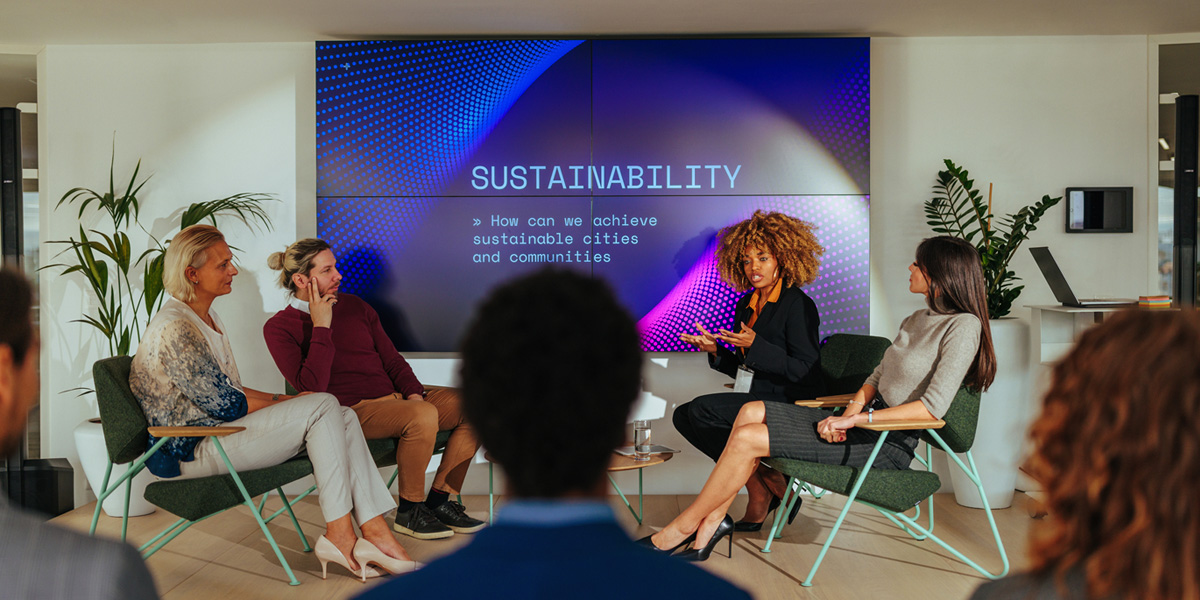Updated: November 2025
One of the defining concepts of our era is sustainability, which has reached every facet of our society and had major impacts on the ways we work and live. Sustainability is based on the scientific understanding that:
- Our world has a finite supply of resources.
- We need to create, consume and live in a way that does not push this balance of resources beyond the tipping point.
Sustainability has become a key concept for many businesses, even becoming a discipline itself. This is reflected in the sustainability hiring boom, which shows that businesses are willing to invest long-term in people and practices that help them meet sustainability goals.
The word “sustainability” is constantly used in internal and external communications at many companies, but there isn’t always a cohesive understanding of what sustainability looks like in practice. It involves more than simply “using less.” True sustainability requires examining the complex systems we rely on and finding ways to improve them without causing harm elsewhere. Here are some examples of what sustainability looks like in practice for an organization.
Sustainability Research and Assessment
The first step toward sustainability is conducting a thorough assessment of organizational practices.
For digital companies that primarily create digital products — such as data collection, storage or processing — this means focusing on energy consumption, both in the office and in the location. Evaluating energy sources of server space used is crucial.
For a manufacturing company, sustainability involves assessing how products are made and moved. Examining everything from the procurement of raw materials to transportation to the manufacturing process itself enables teams to make informed decisions, including where to source materials. Mapping out these systems allows organizations to identify where they can make more sustainable choices.
Once you have created an assessment and carbon footprint, you can start to create a set of goals for your organization and find ways to improve sustainability and offset any unavoidable issues.
Acting on Your Findings
Now that you have a map of the inputs and outputs, an effective sustainability plan requires action. If you find your company is using servers in a region or country that depends on high-carbon energy production, you can research alternatives and put together a cost-benefit analysis of moving your data storage elsewhere. You can also partner with the digital infrastructure team to work out a more distributed model that stores data in multiple places.
Sometimes the focus on one kind of sustainability can lead to its own issues. If, for example, your organization is buying recycled raw materials to create products in the name of sustainability but is shipping those products from overseas, the benefits might be wiped out or eclipsed by the carbon cost of getting the goods to your manufacturing center. In this case, finding a supplier that is closer or using nonrecycled material might actually be more sustainable.
These examples reflect the many ways you can create and achieve a set of sustainability goals. When you can’t alter unsustainable business practices because of high costs, supply chain issues, or other snags, you can also find ways to offset their impact. Sustainability planning means recognizing these nuances and balancing both environmental and business realities.
Offsetting
Sustainability is built on the idea that sustainability practices are both “good in general” and “good for business.” This principle is supported by the growing customer demand for sustainable and clean products. However, sustainability still must make financial sense, which can be difficult, particularly for smaller organizations. You can still achieve sustainability goals by offsetting.
One way to offset successfully is to gather ideas and create programs that cost much less but have an outsized carbon reduction. If you find that many or all your staff are driving to work, provide incentives for them to use public transit or bike to work — or encourage remote work. You can donate used office goods and electronics to an environmental cause or e-waste recycling service.
Another way to offset this is to work with a local sustainability nonprofit or non-governmental organization by either donating, offering free use of your products, or some other form of assistance. You can also encourage your employees to volunteer for sustainable causes, educate them about sustainable practices at home, and bring in sustainability educators to hold a seminar.
You can also make this work a part of your organization’s profile or brand, informing customers or clients about sustainability and encouraging them to donate, volunteer or learn more about best practices.
Prepare for Your Career in Sustainability at Columbia Southern University
The ability to assess organizational practices, collaborate across departments, stay current with evolving technologies and design programs that engage both employees and customers are all critical skills in the sustainability field.
As demand for sustainability professionals grows, education plays a key role in preparing leaders for these challenges. Academic programs – such as the sustainability concentrations in Columbia Southern University’s bachelor’s degree programs in environmental management and occupational safety and health – equip students with the knowledge to help organizations build a more sustainable future. Continuing education courses, such as CSU's carbon credit markets, offer a concise learning option for specialized knowledge in this industry.
An education in sustainability provides the foundation to make a lasting impact. Learn more about our programs here.
Disclaimer:
Continuing education programs are not eligible for Federal Student Aid, military tuition assistance, VA funding or Learning Partner discounts.
Multiple factors, including prior experience, geography, and degree field, affect career outcomes. CSU does not guarantee a job, promotion, salary increase, eligibility for a position, or other career growth. Testimonials may not reflect the experience of all CSU students.





